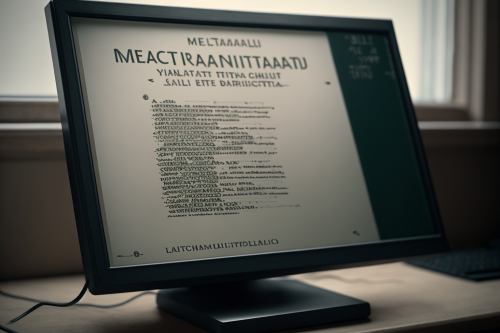

Metadata translation is the process of localizing your Salesforce apps and custom functionality for a specific language. It can be a useful tool for enabling your users to interact with Salesforce content in their native language.
It can also be used to support the internationalization of your web site. This includes SEO optimization and ensuring your content reaches the right audience.
Titles
Whether you’re translating website titles and meta descriptions or journal articles, metadata is important. It helps people find your content, which can make the difference between a sale and a click-away. For this reason, it’s best to ensure that your metadata is well translated and accurate.
It’s also important to understand that users will likely view your metadata before they even see your content. They may base their entire decision to visit your site on the content they see within your metadata, so make sure that your metadata is correct and speaks to them in their language.
For example, when translating a book’s title, it’s often better to avoid ambiguous keywords. Instead, use descriptive, concise text. This will help your content appear in the right search results for your target audience and keep your visitors from going elsewhere.
If you’re working on a project with multiple languages, it’s good to provide the translations well in advance of publication. This will allow supply chain partners in the foreign country to order and stock your books. If you don’t, you could face inventory shortages or other difficulties that will hurt your business.
Another consideration is that if you have a large number of pages, it’s best to use short, descriptive titles and meta descriptions. Long titles and meta descriptions can be hard to read, especially on mobile devices.
It’s a good idea to make your page titles and meta descriptions less than 600 pixels wide, as this is the recommended minimum for web browsers. If you’re not sure, it’s easy to check using free pixel width tools like Yoast SEO.
While you’re at it, make sure to keep your meta description concise and relevant. The title and description are often the first things that users will see when they view your site, so they have to catch their attention quickly.
It’s also good practice to add a brief, relevant note at the beginning of each article about how the work was named in other languages. This will help readers decide if they want to read the article in their own language.
Descriptions
Metadata is the content that tells a user what a piece of information is, and it’s important to make sure that yours is accurate. Your metadata can include details about the product or service you are offering, your intentions or goals, and even the meanings of specific words or phrases.
The most effective metadata is one that communicates what a person needs to know to use a resource effectively. That’s why it’s often the first thing a potential customer sees in a search engine results page (SERP).
You can also add metadata to your OLAC-compliant documents that will help researchers to find them. For example, you could add a list of references at the end of your book or article.
Creating and managing metadata is something most archives have already done, and it’s usually quite straightforward for resources that have been digitized or uploaded to a database. However, some archives have not yet made their metadata OLAC-compliant.
For this reason, they might be in need of a way to map their non-OLAC metadata into OLAC format. This process is sometimes called crosswalking” or mapping” and involves identifying which metadata from one format are equivalent to those in the other, and then determining the translation key that will allow the data to be accessed in the new format.
This process can be time-consuming, and it’s not always easy to figure out how to do. That’s where computer-assisted translation tools come in.
There are several methods of translating your OLAC-compliant data into non-OLAC formats, and the one that will be most efficient for you depends on what you want to do with it. Typically, if you’re simply wanting to make your resource more accessible, then it will be best to create a non-OLAC version of it.
But if you’re interested in making your resource more accessible to linguists, then it may be worth considering creating a version that is fully OLAC-compliant. That way, linguists can locate your resource easily via Google or other search engines and then can access the raw data within it through any software that supports it.



Keywords
Metadata is a collection of data that search engines use to categorize and order information online. This includes things like meta descriptions, tags and image alt text. When you’re trying to get your website to rank well in search engines for different languages, it’s essential that you translate these metadata elements as much as possible.
Your page titles and meta descriptions are the first thing that people read when they visit your site. They help to decide whether they’ll click through to your page or not. If they’re not properly translated, or contain the wrong keywords, your pages aren’t going to rank highly.
Keywords are important for SEO, but they can also be problematic if you’re trying to reach a new target market. This is because a keyword on your English website may have a different meaning in a country with a different language.
It’s important to carry out thorough keyword research before launching a website in a new market. This helps to identify which words and phrases are most relevant for a new audience, which will make it easier to find your site in their native language.
If you want to be able to capture and translate these keywords for your site, it’s a good idea to use advanced keyword tools that can analyze the competition and uncover which terms are most used. You can then use those words and phrases to create a keyword list for your site that is specific to the new markets you’re targeting.
Once you’ve created a list of keywords, it’s time to start translating them. This means translating your website content and metadata in a way that uses these keywords in a natural and effective manner.
While keyword translation is a complicated process, it can be worth the effort if you’re looking to expand your business into new markets. It can also help you to better understand your target audience, which is crucial for making sure your website stands out from the competition and reaches a larger audience.
It’s important to remember that SEO is a long-term strategy, not a quick fix. You’ll need to be consistent with your strategy across all areas of your business to get the most out of it, including your website and marketing materials.
Tags
If you’re looking to optimize the metadata on your site, it’s important to consider how it will appear in SERPS (search engine results pages) across different languages. This can have a huge impact on how well your site or page is found and ranked.
Metadata is important for SEO, as it helps a page or site stand out from the competition. It can also be used to inform customers about the page or site, while enticing them to click through and read more.
There are several ways to do this, but one is through the use of tags. These are short snippets of information that can be inserted into a website or page’s HTML, which can then be translated into other languages and viewed on search engines.
Getting these snippets right can be an easy job, however it’s important to ensure that you don’t overwrite or miss out on any important details. For example, if your snippets are too long or include too much text, they’ll have a negative impact on your search engine rankings.
Another way to make your snippets more accurate and enticing is by using keywords. Using the right density of keywords can help your page or site rank highly on search engine results pages, and will therefore be more likely to attract new customers.
This is done by including a keyword or phrase that’s relevant to the language your metadata will be displayed in. This can be as simple as adding a key word that you know your target market uses when they write about your products or services, or it could be as complex as putting together a glossary of keywords, which you can share with the translation company.
The metadata translation process isn’t easy, but it can be a worthwhile investment. Using the right tool will save you a great deal of time, and help your content be seen by more potential customers.















